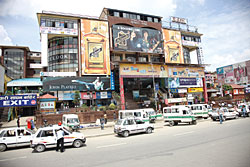 PICS: ANUP PRAKASH |
Shopping malls first emerged in the early 1920s in the United States, where they replaced department stores, but didn't grow into today's gigantic mega-malls until the 1980s.
They filtered into Asia following the meteoric growth of the East Asian economies in the 1990s, and gave rise to a generation of hip youngsters who indulged in a new 'mall culture'. They didn't so much shop in malls as 'hang out', which meant chatting, watching movies, browsing shops, bowling and gaming--the whole nine yards of modern-day entertainment for kids.
Kathmandu malls are far smaller than their international counterparts but like them have sparked a new lifestyle.
"I hang out in malls during weekends with my friends and we usually eat, bowl and watch movies," says student Sarif Maharjan.
Nepal's largest mall, City Centre (top), is a milestone in Nepal's burgeoning mall culture. It has a food court and a 4D theatre where the seats rumble and shake in response to the events unfolding on the screen, adding another 'dimension' of sensation. And of course, it has dozens of chic, modern brand name stores.
Mannsi Agrawal of City Centre says, "Attracting customers means not just having good shops but entertaining them as well. People should be happy when they leave the complex."
Recently opened Sherpa Mall has now become the hip spot for youngsters. "I just love the ambience," says Samana Shrestha, 18, enjoying an ice-cream. "It's a great hangout." Located in Darbar Marg, Sherpa Mall is especially popular with the young adult crowd as it offers a good mixture of dining and shopping.
But there is a darker side to the mall boom. Kathmandu's old network of stores, some of which have been around for many generations, are feeling the heat as they lose business to newer, glitzier competition.
Sambrina Napit, who owns a store opposite City Centre, says she's lost 50% of her business since the mall began operations and is now considering closing down. "We just can't compete. They can offer huge discount schemes because they buy things in bulk, which we can't do," she complains. A neighbouring store has it worse, having lost all of its business to City Centre's supermarket Big Mart.
 |
One shopper says, "I can go to this clothes store that my family has used for generations, and the shopkeepers will know exactly what I want because he's known my family for so long."
So far, the service in malls has caused some resentment among shoppers, and not only because they're unaware of each shopper's individual needs. The service is just bad, period.
Architects Prajita Joshi and Shobhana Rajbhandari complain, "We can't even tell the salespeople apart from the shoppers."
Another common complaint is that salespeople seem indifferent to their customers, showing them what they ask for, but rarely encouraging them to explore other styles and colours and so forth. Compare this to the scene in traditional sari stores, where salespeople will throw down dozens of rolls of saris to entice hesitant customers. This kind of enthusiasm is rare in malls.
Along with the high prices, this is partly why malls haven't fared as well as their proprietors hoped, although business certainly isn't slumping. Prices are high because malls have to cover for lighting, parking spaces and air conditioning. There's also ample competition, with at least half a dozen malls already in the city. As a result, few stores enjoy a regular stream of customers.
"I have some doubt about sales, but it's a start," one proprietor insists.
It's make or break for many this Dasain--the gloves are off and the sales are on.


